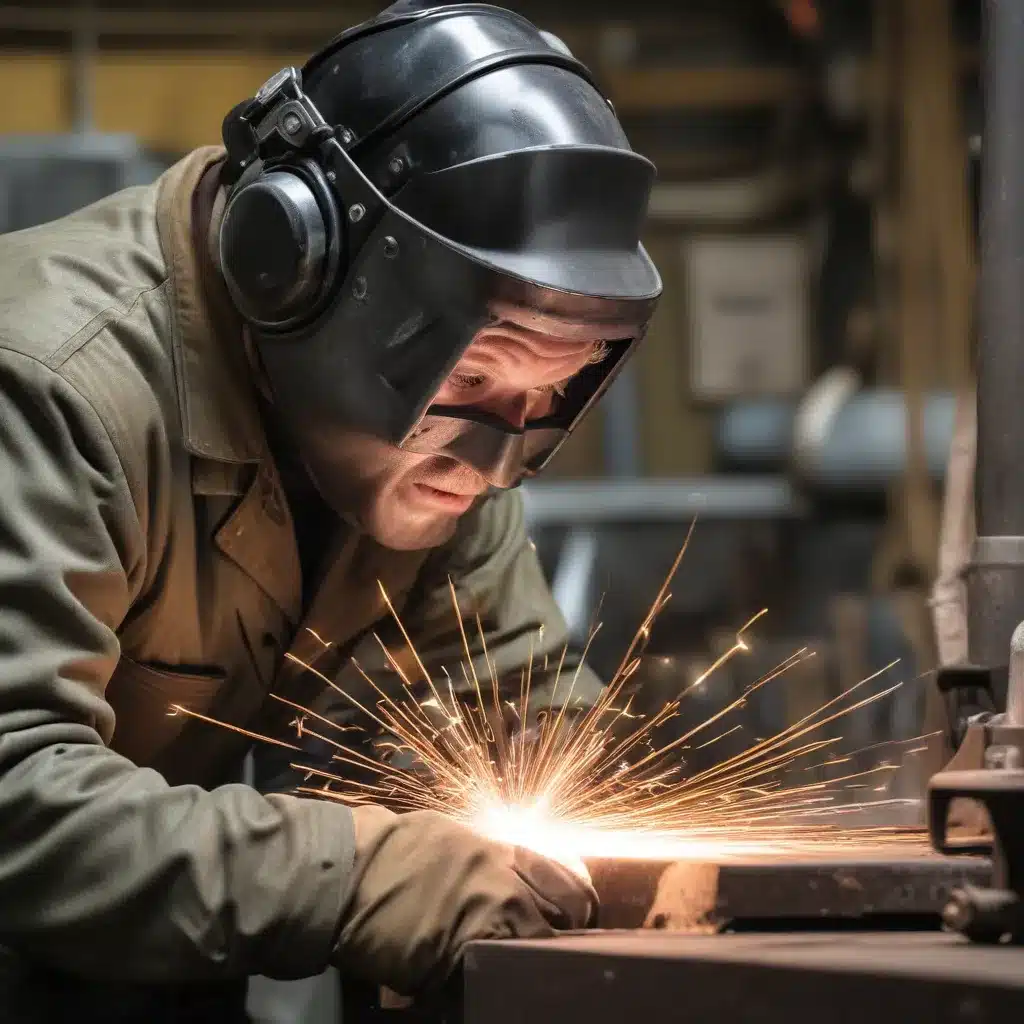
Mastering the Art of Noise Control in Welding and Fabrication
As an experienced welder and metal fabricator, I’ve seen firsthand the importance of prioritizing hearing protection in our industry. The reality is, the very processes that make us skilled metalworkers – welding, cutting, grinding, and more – can also pose a serious threat to our auditory health if we’re not proactive about managing the noise.
Let me share some of the hard-earned insights I’ve gained over the years. The din of an electric arc, the powerful hum of a compressor, and the echoing clangs of the workshop can quickly add up, putting our hearing at risk. But with the right strategies and equipment, we can safeguard our precious senses and continue to thrive in this dynamic field.
Understanding the Decibel Dilemma
First, let’s dive into the science behind the noise levels we encounter. Sound is measured in decibels (dB), a logarithmic scale that can be deceiving at first glance. The difference between 10 and 20 dB may seem small, but the jump from 50 to 60 dB is far more significant.
Here’s a quick reference:
– 0 dB: The threshold of human hearing
– 60 dB: Normal conversation
– 80 dB: Loud traffic or a noisy office
– 90 dB: OSHA’s permissible exposure limit for an 8-hour workday
– 100 dB: A jackhammer or a rock concert
– 120 dB: A jet engine at takeoff
Now, the tricky part is that the human ear doesn’t perceive all decibels equally. That’s where the dBA (A-weighted decibels) scale comes into play, which better reflects how our ears detect and react to different sound frequencies. This nuanced understanding is crucial when evaluating the noise hazards in our workshops.
Confronting the Noise Culprits
Let’s take a closer look at the primary noise sources we encounter in our line of work. Welding and plasma cutting procedures, for instance, can generate sounds ranging from 85 to 110 dBA, while air compressors often operate between 40 and 90 dBA. And the dreaded angle grinder can crank out noise levels up to 105 dBA.
These figures underscore the sheer volume of sound we’re regularly exposed to. Even the “quieter” processes can be harmful over time, as the cumulative effect of noise exposure takes its toll on our hearing.
Reducing Noise at the Source
The most effective noise control strategies start at the source. One of the best ways to lower the decibel output is to invest in more modern, well-designed equipment. Older, cheaper machines tend to be noisier, as they often lack the sound-dampening features and engineering innovations found in newer models.
If upgrading your entire setup isn’t feasible, consider some alternative solutions. A water table, for instance, can help dampen the noise generated by welding and plasma cutting, as the submerged work surface absorbs sound waves. Alternatively, an enclosed, sound-insulated cutting box can also help contain the racket, although it may be less convenient to use.
For the ultimate in noise reduction, look into computerized, isolated cutting systems. These CNC machines handle the heavy lifting, allowing the operator to step away from the noise while the computer-controlled process does its magic. Of course, the price tag on these high-tech solutions can be a significant investment, but the benefits to your hearing health may well be worth it.
Protecting Yourself with Proper PPE
While reducing noise at the source is crucial, personal protective equipment (PPE) is the backbone of any comprehensive hearing conservation program. And in our industry, earplugs and earmuffs are as essential as our welding gloves and steel-toed boots.
Now, simple foam earplugs may not be enough to shield your ears from the high-decibel onslaught of welding and fabrication. Investing in higher-quality earmuffs or combining earplugs with earmuffs can provide much more effective protection. Some advanced models even incorporate features like radio communication, allowing you to stay connected without compromising your hearing.
Remember, it’s not just about the dB level – the duration of exposure matters just as much. OSHA’s permissible exposure limit of 90 dBA for an 8-hour workday means that for every 5 dB increase, the allowed exposure time is cut in half. So, if you’re working in a 95 dBA environment, your safe exposure time is just 4 hours.
Empowering Operators with Knowledge
Keeping our teams informed and engaged is crucial to the success of any noise reduction program. Educate your fellow welders and fabricators on the science behind decibels, the importance of hearing protection, and the various control measures available. Encourage them to speak up about noise concerns and to take an active role in maintaining a safe, low-noise work environment.
By fostering a culture of awareness and shared responsibility, we can empower our colleagues to make informed decisions and take the necessary steps to safeguard their hearing. After all, the long-term consequences of unprotected noise exposure can be devastating, robbing us of the very senses we rely on to excel in our craft.
Pursuing Continuous Improvement
As with any aspect of our work, the pursuit of excellence never ends. Regularly conduct noise surveys, assess the effectiveness of your control measures, and stay up-to-date with the latest industry best practices and technological advancements. Collaborate with your peers, share what’s worked (and what hasn’t), and continuously refine your approach to ensuring a safe, low-noise work environment.
Remember, our hearing is a precious gift that we must protect with the same fervor we bring to perfecting our welding techniques or fabricating intricate metal components. By prioritizing noise reduction strategies and empowering our teams, we can continue to thrive in this dynamic industry while safeguarding our most valuable asset – our ability to hear the world around us.
If you’re in the market for new welding equipment or accessories, be sure to check out https://theweldfab.com/. Their extensive rental fleet and commitment to quality ensure that you have the tools you need to work safely and efficiently, without compromising your hearing.


